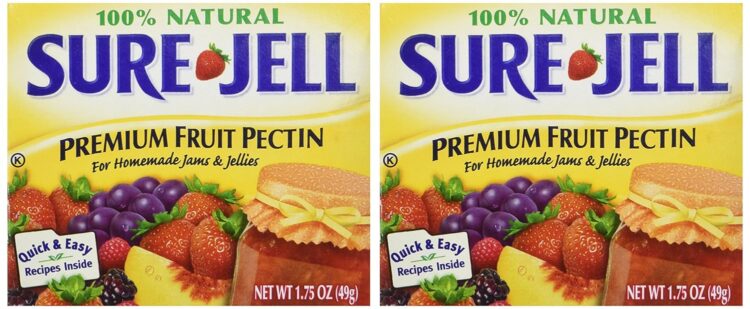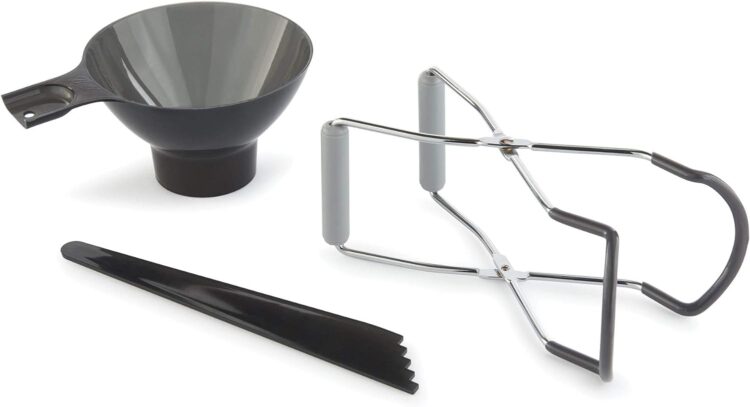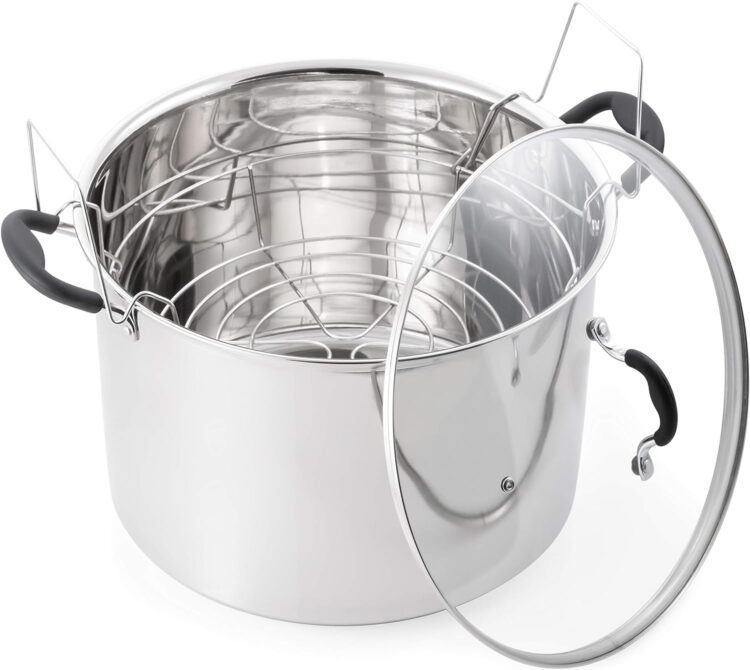About 4 years ago mom and I decided to take my daughter mini golfing.
Well, somehow I managed to miss the exit for the golf course we had decided to visit. Being optimistic and rather used to dealing with my driving errors, we decided to just continue heading north. I was certain there’d be another course ahead. The GPS confirmed my hunch and directed us to a park situated on a small island. It looked like the perfect place to spend our afternoon.

We made our way to the mini golf area, passing numerous flowering bushes and trees. It really was a beautiful location.
I had no way of knowing this park held a treasure I had sought for years.
Mom spotted it first and called for me to come over. Curious what she had found, I hurried to her side. When I saw what she had discovered I could not believe my eyes – saskatoons – growing on a tree! I was so excited.
After almost two decades of being without, I could once again make saskatoon jelly and pancake syrup, my favorites since I was a child.
I had been searching for saskatoons for years. These berries grow in the wild a few feet from my parent’s Alberta home, and I was certain they would grow in Maryland’s climate too. I had asked around but to no avail, no one knew what saskatoons were – let alone where to find them. I had even placed a query online to see if anyone had saskatoon berries to sell. No luck. I had to accept that they would be a special treat to enjoy when I visited my family up north.
Soon after we arrived home I called the park supervisor. He granted me permission to pick the berries (though I am not going to lie, we could not resist tasting a few while we were there). A couple of days later we arrived armed with buckets and, though it was late in the season, we acquired enough berries to make five jars of jelly. The taste was amazing, well worth the wait. Missing that exit was definitely a blessing in disguise!
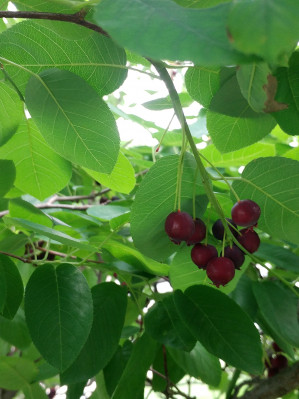
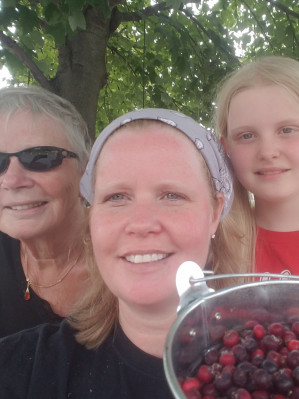
Armed with renewed confidence that saskatoons DO indeed grow in my area, I resumed my search. I was determined to purchase my own saskatoon bush. The park was beautiful, but it was a 3-hour round trip to pick fruit; with no way to tell if they would be ripe when I arrived.
As it turns out I had been using the Canadian name for the berries, unaware they had a different name south of the border. Here in the US they are known as shadberries, serviceberries, or Juneberries. Now I was getting somewhere!
I found several sites to purchase these plants online and eventually decided on a Downy Serviceberry cutting. It was about 12 inches tall when it arrived. Not the best with gardening, I carefully followed the instructions for unboxing and acclimating my cutting. I planted it in a protected spot near the front of our house. If it took, I’d have my own serviceberries to enjoy in 3-4 years.
Content with my purchase and knowing the location of mature trees to harvest berries come spring, I went about my daily routine.
About a year later, I had reason to go inside my bank rather than use the drive-through as I was accustomed to doing. As I exited my car, I noticed several small trees with red berries on them planted along the perimeter of the bank’s parking lot. This piqued my curiosity. Upon closer examination- and to my great surprise- they were saskatoons! I felt elated… and a bit foolish at the same time. I had spent all this time searching, yet here they were, just 2 minutes from my home!
After getting permission from the bank’s manager, my daughter and I picked three pails of berries that evening. The next day the entire family helped, including my husband and son. In total we picked 13 lbs of berries.
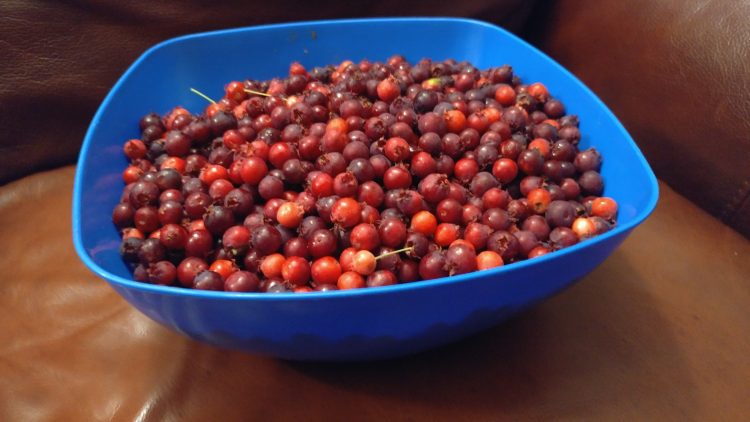
Several people stopped to ask what type of berries we were picking and what we planned on using them for. I enjoyed educating them about the fruit and encouraged them to try some. Most people liked them, a few even said they’d come back later to pick some too. Hopefully they did, as there were plenty to share.
What to do with all those berries?
As I mentioned earlier, they can be enjoyed fresh (in moderation – see next paragraph) or processed into jelly and syrup. Saskatoons can be substituted for blueberries in pretty much any recipe. This means they can be used in soups, pies, tarts, cookies, cakes, muffins, crumble, and so much more. Home fermenters may want to try making saskatoon wine, cider, or beer. I can vouch for the wine- it’s delicious! (winemaking is one of my mother’s many talents). Saskatoons can also be dried and added to trail mix. Whole berries freeze well. Try combining the frozen berries with raspberries or strawberries to make a tasty smoothie. My daughter recently found some berries in our freezer and has created some unique and delicious blends.
So, what’s the big deal about saskatoons? They are healthy and delicious! Though they are close relatives of the apple (pome) family, saskatoons (serviceberries, Juneberries) look like dark red blueberries. Saskatoons and blueberries boast similar health benefits but, in my opinion, saskatoons are much tastier. Rich in vitamin A, vitamin C (higher levels than blueberries), folate, biotin, and the minerals iron, manganese, and potassium, I believe the saskatoon deserves to share the blueberry’s superfood status. Saskatoons are high in fiber and contain phenolic acids, anthocyanins, and flavonoids – antioxidants which prevent cell damage, reduce the risk of cardiovascular disease, fight cancer, and provide anti-aging, anti-inflammatory, and antimicrobial effects. Oh, and provide possible UV protection. Those are some powerful berries!
A word of caution: if you eat saskatoons (serviceberries, Juneberries) fresh, be careful not to eat too many, and keep fresh berries away from pets. The seeds contain cyanogenic glycosides (the same toxin found in apple seeds and apricot pits) which can produce toxic hydrogen cyanide when chewed or crushed. Cyanide is a harmful neurotoxic when ingested in large quantities. The good news is this toxin is destroyed by cooking or dehydrating the berries.
Recommended Canning Supplies
As an Amazon Affiliate I am compensated for qualifying purchases, at no additional cost to you
Saskatoon Syrup Recipe
If you love pancakes but haven’t tried them with saskatoon syrup, you are missing out! Slightly tangy, with a distinctly bright taste, it is a refreshing change from the usual. Here is my recipe, let me know what you think in the comments below.
Supplies You Will Need:
- about 8 cups of saskatoon berries
- 5-6 pint-sized canning jars with lids and bands
- 3 layers of cheesecloth, cut or folded into 12 x 12 inch squares (or larger – it must fit over your sieve)
- 1 pair heavy rubber gloves or similar hand protection
- large saucepan to boil berries and make the syrup
- large pot for water bath canning (see link above for a 21.5 qt. Stainless Steel pot)
- a jar lifter
- colander or sieve
- potato masher
- long-handled wooden spoon
- metal spoon or small metal sieve (to skim foam)
- large glass or metal bowl
- a clean, dry cloth or towel to set filled jars on
To make berry juice:
Wash berries and place them in a large saucepan. Add a small amount of water (about 1-2 inches) to the bottom of the pan. Cook over medium-low heat until the berries are soft. Remove from heat. Using a potato masher, squish the berries to help release their juice.
Line a sieve or colander with 3 layers of cheesecloth, leaving some cloth hanging over the edges. Place the sieve or colander over a large metal or glass bowl, this bowl will be used to collect the strained berry juice (I use an extra-large glass measuring cup).
Using a soup ladle, carefully scoop 2 spoons of hot berries onto the cheesecloth. The liquid will drain into the collection container below. (At this point, place gloves on to protect your hands from the heat, and to prevent the staining of your nailbeds). Once the liquid has slowed, gather the cheesecloth in your hands and squeeze it to release any remaining juice. Caution, the berries will be hot. Once the berries have released all their juice, open the cheesecloth and discard the seeds and skins. Rinse the cheesecloth if needed in cool water, wring it out well and begin the straining process again. Continue until all the berries have been used, then discard the cheesecloth. Measure the berry juice. You will need 3 cups for the syrup recipe. (If needed, add water to get to the 3 cup measure). Save the remaining juice (if any) for soup, smoothies, or other recipes. I pour the juice into ice cube trays and freeze it for smoothies.
Saskatoon Syrup
3 cups saskatoon berry juice
½ cup lemon juice
3 Tbsp (36 grams) fruit pectin (I use Sure Jell, to purchase see link above)
2 ½ cups granulated sugar
Prepare canning jars and lids by washing and sterilizing them. Keep jars warm while you make the syrup. Fill a second, larger pot with enough water to cover the jars by 2 inches of water when standing in the pot. This water will be used for processing the syrup, known as water bath canning. Set aside. (Note- I streamline my canning process by boiling my clean jars in the water-bath canning pot, then let the jars sit in the hot water until I am ready to fill them. This way the jars are sterilized, and the canner water is heated and ready for the filled jars. I add the lids to the hot water just prior to sealing the filled jars).
Pour the strained berry juice, lemon juice, and pectin into a large saucepan. Bring to a boil over medium heat, stirring continuously.
Once the juice mixture is boiling add the sugar all at once. Stir briskly and continue to heat. Cook at a rolling boil (cannot stir down the boil) for 2-3 minutes. After 2-3 minutes, remove saucepan from heat. Scoop any foam or bubbles from the top of the sauce using a metal spoon or sieve. Place sterilized, warm jars on a clean, dry cloth. Using a funnel, fill each jar leaving ½ inch of headspace from the rim. Once jars are filled, wet a paper towel and wipe the jar rims to remove any juice. Place clean lids and bands on jars, finger tightening the bands (but not too tight).
Now you will stand the jars in the water bath canner. They should be fully submerged, with the water at least 2 inches above the top of the jars. Heat the water over medium-high heat until boiling. Once the water is boiling set a timer for 10 minutes. You will notice bubbles rising from inside the jars as the air escapes.
After 10 minutes remove jars using the jar lifter and set them on clean, dry towel. Let jars sit for 6 or so hours as they cool and seal. As the jars seal you may hear a popping sound.
When the jars are cool, check the seals. The lids should be concave or sunk slightly in the center and not bounce back when depressed with a finger. Remove the bands and wash the jars as they may be sticky.
Label and store your syrup in a dark, dry location.
In my opinion, the syrup tastes best warm.
Pour the amount you wish to use into a microwave safe bowl and heat for a few (5-10) seconds.
Open jars of syrup can be kept in the refrigerator for up to 2 weeks.

